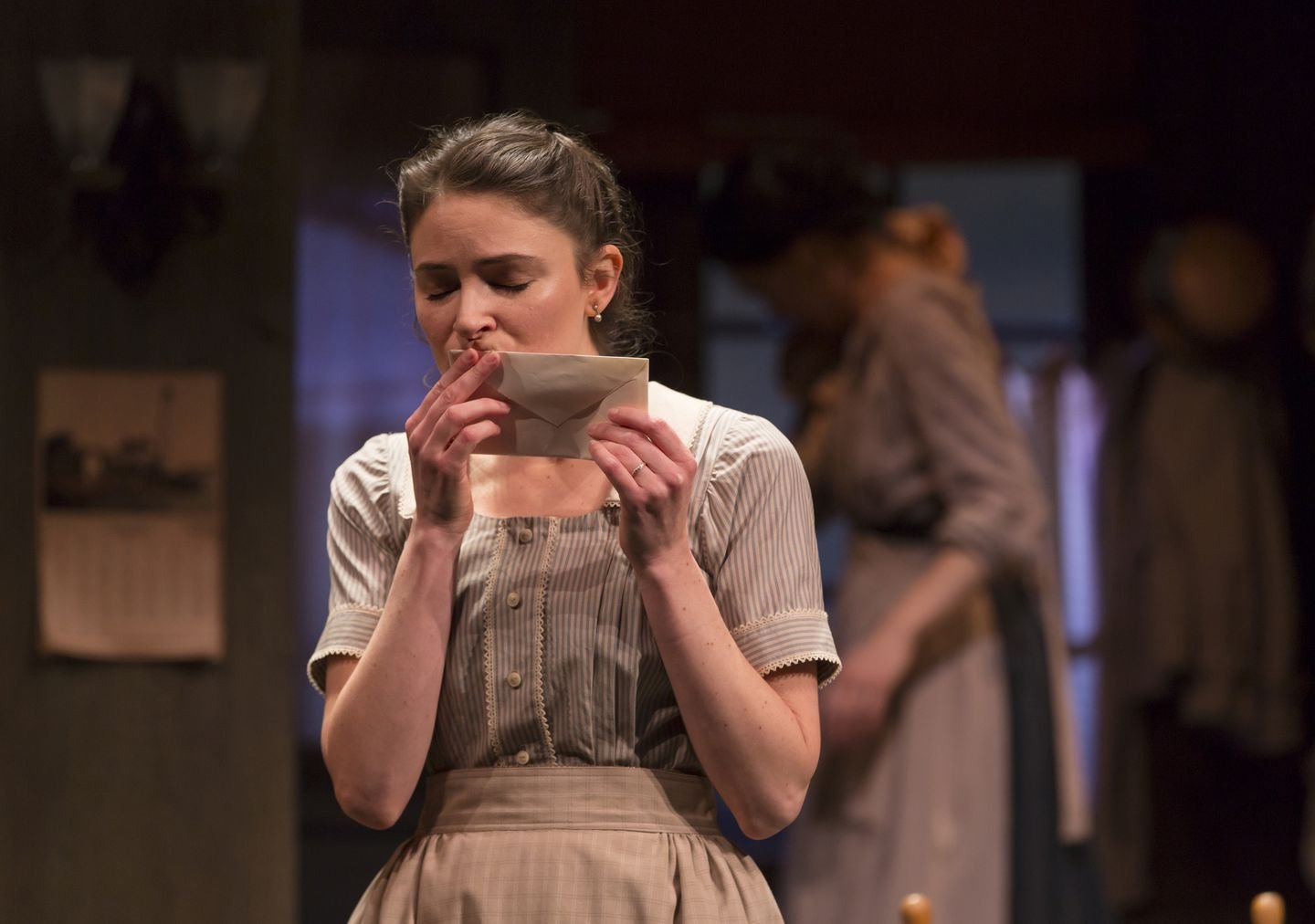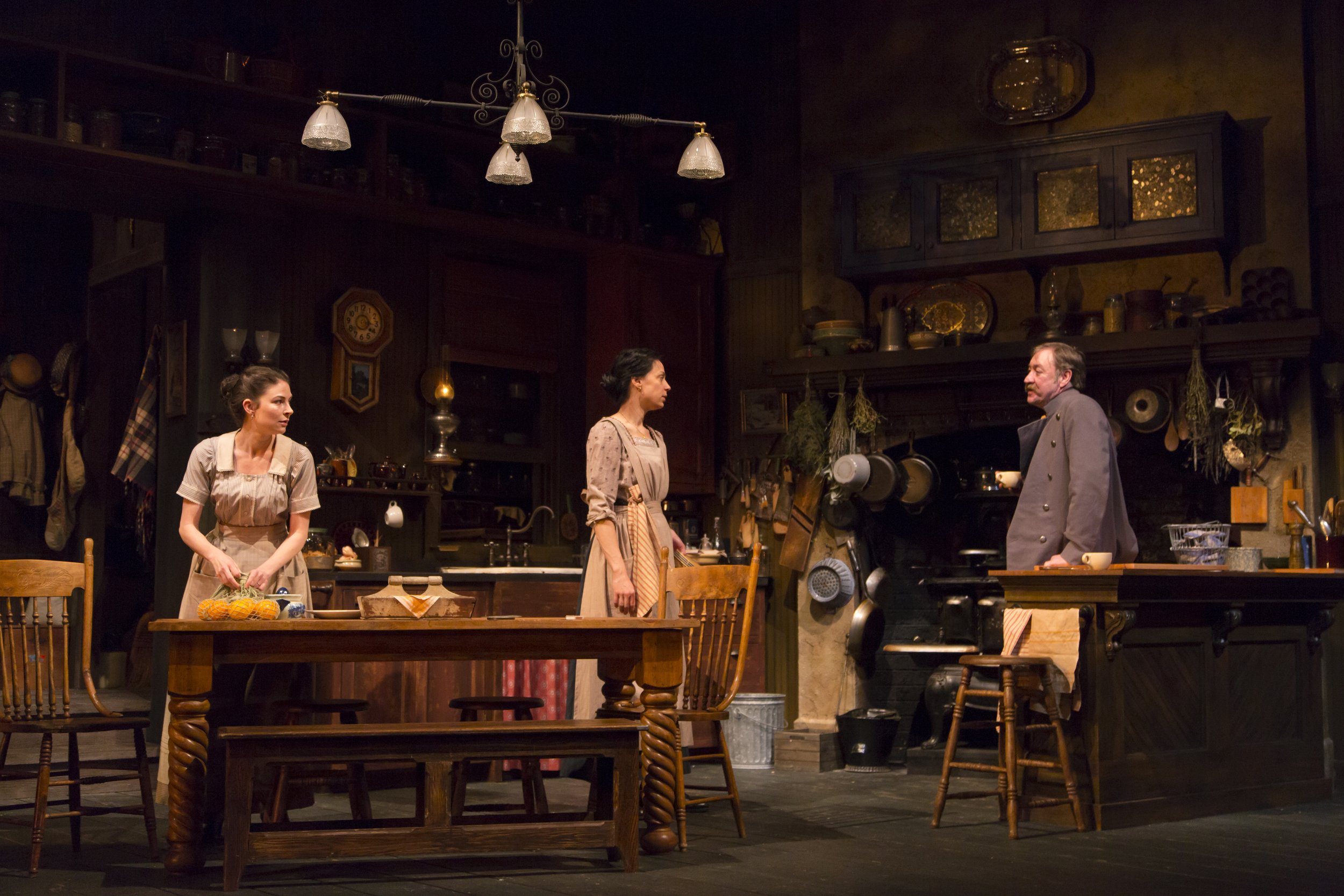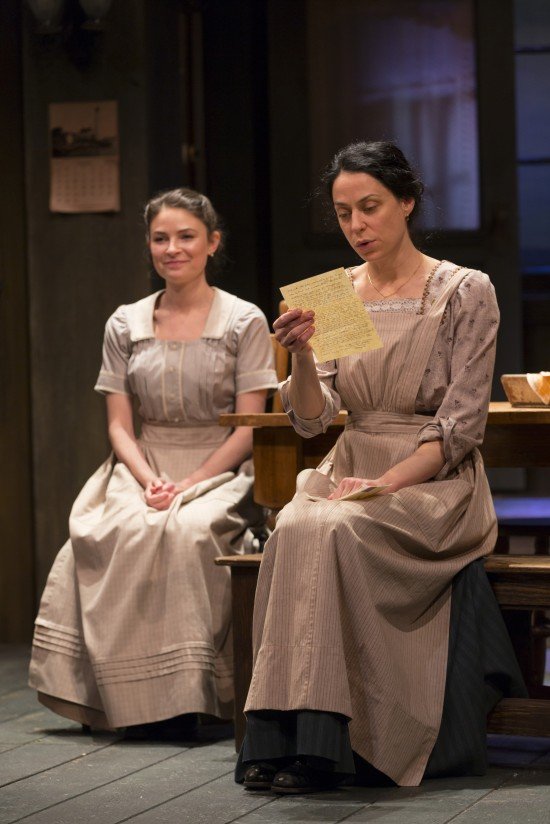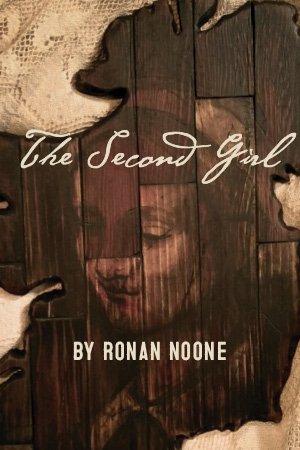“…I found it very satisfying to watch this master craftsman working in an unaccustomed idiom, patiently building character on a series of small moments, some of them quite beautiful.”
—Don Aucoin, The Boston Globe





The story
An Ode of Passion, Heartbreak, and Humor.
“…a broken heart is not a qualification to being Irish—’tis getting up with the pieces of the heart in your hand and asking the fella who broke it if he wouldn’t mind giving you a kick in the head, too—that’s Irish.”
With Eugene O’Neill’s classic Long Day’s Journey into Night as a backdrop, The Second Girl is set in the downstairs world of the Tyrone family kitchen in August 1912. Two Irish immigrant servant girls and the chauffeur search for love, success, and a sense of belonging in their new world in this lyrical and poignant world premiere by Huntington Playwriting Fellow Ronan Noone (Brendan, The Atheist) and directed by Campbell Scott (The Atheist).
With Eugene O’Neill’s classic Long Day’s Journey into Night as a backdrop, The Second Girl is a lyrical, wrenching, and caustically funny play. Set in the downstairs kitchen of the Tyrone family’s summer residence, circa 1912, Noone’s characters—two Irish immigrant servant girls and a chauffeur—struggle with denial, personal responsibility, and failure, while searching for love, belonging, and a sense of what it really means to call some place ‘home.’
“The Second Girl is the reason I began writing plays. It tells an immigrant American story about what it means to come to America and what America means to so many. It is a thrill to have this play go up in my hometown and at the Huntington Theatre Company, and it is tremendous to be working with Campbell Scott again.” —Ronán Noone
PRODUCTION INFORMATION
Published by The Eugene O’Neil Journal
Produced by
The Huntington Theatre Boston
Contemporary American Theatre Festival (WV)
Martha’s Vineyard Playhouse
Awards
The Inaugural Excellence in Playwriting Award from ATHE for The Second Girl
The Second Girl is the recipient of an Edgerton Foundation New American Play Award
PLAYWRIGHT’S NOTE
The Second Girl was originally produced by the Huntington Theatre Company, Boston. Peter DuBois, Artistic Director / Michael Maso, Managing Director. The Second Girl was developed by The Orchard Project, American Conservatory Theatre, CATF, Vineyard Playhouse, and Boston Playwrights’ Theatre.
Watch a behind the scenes video of The Second Girl
Nice Things People Have Said
“Ronan Noone has been a central part of the Huntington’s family since 2003 when he was named to the very first cohort of Playwriting Fellows. Our audiences responded so warmly to Brendan, his play about an Irish immigrant finding his way in his adopted home of Boston, and I know they’ll feel the same about his latest work that intimately explores the longings of the secondary characters from one of the 20th century’s greatest dramas.”
—Peter DuBois
“I am thrilled to be working at the Huntington for a third time, especially in the new capacity as director of Ronan Noone’s compelling new drama The Second Girl. This is mature and subtle playwriting, and I can’t imagine a better theatrical environment in which to premiere it or a more perceptive audience with whom to experience it for the first time.”
— Campbell Scott
The Second Girl At Huntington Theatre
Moving Irish-American Drama At Calderwood
By Mark Favermann, January 30, 2015
The Second Girl
by Ronan Noone, Directed by Campbell Scott
Cast: Kathleen McElfresh (Bridget O'Sullivan); Christopher Donahue (Jack Smythe); and MacKenzie Meehan (Cathleen O'leary); with Offstage Voices by Greg Balla and Karen MacDonald. Design: Santo Loquasto, Scenic & Costume Design; James F. Ingalls, Lighting Design: and Ben Emerson, Sound Design.
A play in Two Acts with a 10 minute Intermission
Presented by the Huntington Theatre Company At the Calderwood Pavilion
at the Boston Center for the Arts in Boston's South End.
Thanks to PBS, we are all familiar with the upstairs/downstairs dichotomy of late 19th Century and early 20th Century domestic servants versus their upper class employers. We tend to root for the lower class characters in the spirit of championing the underdog. With a Eugene O'Neil twist, Playwright Ronan Noone applies this social division deftly and thematically to his world premiere of The Second Girl now playing at the Huntington Theatre's Calderwood Pavilion.
Taking O'Neill's Long Day's Journey Into Night, Noone looks at what the "downstairs" was doing on that same day August 12, 1912 that the earlier American classic took place. Similarly, in this play, like most of O'Neil's characterizations, the playwright involves three characters on the fringes of society. Each struggles to maintain their personal hopes and aspirations, but ultimately they slide into a desperate resolve ending in tragedy.
At the same time, The Second Girl is a thoughtful and poignant drama about the American immigrant experience and ultimately about the textured trials and tribulations of reaching for the American Dream. Noone looks at the darkness of those entering and experiencing the new American world. The one American-born character demonstrates along with the others that choices, happenstance and personal decision-making can harshly effect our lives.
Exquisitely staged by multiple award-winning designer Santo Loquasto, the detailed set is the kitchen and backporch of the affluent Tyrone family. Cooking bacon and roast chicken smells waft through the audience as various meals are being prepared.
The ever-moving lighting designed by James F. Ingalls states both mood and changing times of the summer day. Both the set and lighting expressively set the tone of the play. In fact, rather brilliantly, light and shading are characters in the play.
With a trio of outstanding actors, this Huntington drama is beautifully performed with nuance, sadness and grace. There is a hard-shelled flintiness to Kathleen McElfresh's wonderfully crafted portrayal of the prickly Bridget O'Sullivan. Her characterization underscores Bridget's self-protection and alcoholic self-medication.
Christopher Donahue's sad-sack Chauffeur Jack Smythe provides a quietly heldin belligerent dark side and deep yearning, while the pretty MacKenzie Meehan's Cathleen Shakespeare dialogue-quoting often speaks to her at times delusional optimism. Her performance reinforces her character's charm and edgy hopefulness.
Strangely, none of the characters seemed to have much of a sense of humor, something that generally upwardly striving folks often use as a survival tool. Stoically experiencing life's tragedies and problems, their self-worth sometimes seems to be confused with self-awareness as well. But, this is part of the core of the play: self-worth vs. self-awareness punctuated by love and family.
As characters moved and interacted, Campbell Scott's direction seemed seamless. His direction was a very orchestrated disciplined dance of regimented life and attempts at reaching but perhaps not achieving beyond.
As a brand new play, there are a few editing issues in the narrative: first, the Chauffeur's reference to the "old Packard" is a bit strange in that the year is 1912, and they only started to make Packards in 1903; second, the two servants referred to Mr. Tyrone as His Lordship and Mrs. Tyrone as Her Ladyship. This is not an English drama but an American story, and their employers would have been more normally referred to as "The Mr." and "The Mrs" by staff members. Editing will easily fix these.
The Second Girl is a celebration of a young, emerging playwright with a historical touch and a literary vision. It is a drama wrapped in humanity that transcends its time and place.
